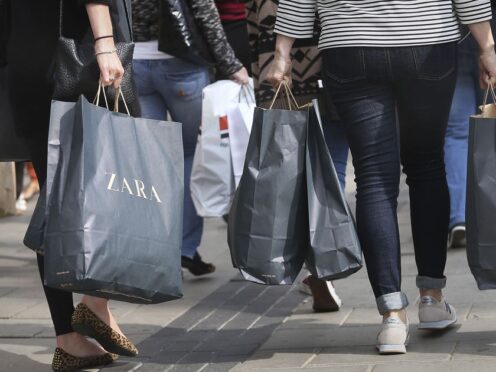
January was a “disappointing” month for Scottish retailers despite a slight increase in sales compared with last year, according to an industry body.
The latest figures show total sales in Scotland increased last month by 1.9% compared with January 2023, when they had grown 9.2%.
This was below the three-month average increase of 2.3% and the 12-month average growth of 6.3%.
Adjusted for inflation, the year-on-year decline was 1%, according to the Scottish Retail Consortium.
Scottish sales increased by 1.2% on a like-for-like basis compared with January 2023, when they increased by 7.9%
Again this was below the three-month average increase of 1.9% and the 12-month average growth of 4.9%.
Total food sales increased by 5.4% versus January 2023, when they increased by 11.1%, but non-food sales decreased by 1% compared with last year, when they increased by 7.6%.
Adjusted for the estimated effect of online sales, total non-food sales decreased by 2.9% in January compared with January 2023, when they had increased by 5.9%.
Ewan MacDonald-Russell, deputy head of the Scottish Retail Consortium, said: “After a bright start, January fell away to a disappointing month for Scotland’s retailers.
“In real terms sales fell by one percent, extending the run of contraction to four months.
“Sales started well around Hogmanay and the first week of the year, but once shoppers returned to work it appears a combination of tightened belts and miserable weather kept them away from the high street.
“Food sales remain solid, with customers focusing on healthier choices following the traditional festive season’s indulgences, with a small spark of Scottish fare for Burns Night.
“Non-food sales were weak across the board, with fitness and health products being the few bright spots. In contrast, furniture sales were weak, a large concern for businesses who traditionally trade strongly in January.
“These weak figures reaffirm the pressure facing both Scotland’s consumers and retailers.
“In that context, it’s astonishing Scottish Ministers are increasing business rates by 6.7 percent on medium-sized and large shops whilst exploring a new surtax on grocers.
“The Scottish Government needs to look at the reality of Scotland’s economy and start helping, not hampering, Scotland’s business community if they want to help deliver economic growth and increase tax revenues.”
A Scottish Government spokesperson said: “In 2024-25, the basic property rate for non-domestic properties with a rateable value up to and including £51,000 will be frozen, delivering the lowest such rate in the UK for the sixth year in a row.
“The budget also ensures that over 95% of non-domestic properties continue to be liable for a lower property tax rate than anywhere else in the UK. The small business bonus scheme offering up to 100% relief from non-domestic rates will be maintained, the most generous relief of its kind in the UK.
“The Scottish Government is committed to ensuring that engagement with the New Deal for Business Non-Domestic Rates sub-group continues to explore how the non-domestic rates system can best support business growth, investment and competitiveness, while acknowledging the important role income from non-domestic rates plays in funding public services.”
Paul Martin, KMPG’s head of retail for the UK, said: “It may be a new year, but the hangover of low consumer confidence remains, with retail sales growing by a lacklustre 1.2% on the high street in Scotland, and online operators seeing yet another month of negative sales performance.
“Highlights in terms of sales boosts centred around sales of toys, games consoles and cosmetics, obviously boosted by the run-up to Christmas. Grocery did well, albeit as expected being pre-Christmas and new year, but this growth was actually the slowest of the year.
“Areas of decline included fashion, furniture and electricals as people pared back spending due to ongoing cost of living concerns. One interesting note was a decline in the sale of Christmas decorations, as people instead decided to reuse rather than buy new.
“It remains a difficult environment for retailers facing into significant downward pressures on demand, a strong promotional environment and uncertainty hitting supply chains due to rising geopolitical tensions.
“Retailers will be hoping that continued good news on the economy, coupled with the small boost given to some consumers as cuts in national insurance start to feed through to pay packets, will boost confidence and convert to sales.
“With increases in labour costs and business rates around the corner, retailers will be hoping for good news in the Chancellor’s upcoming Budget to give consumers that lift they need to start spending again.”

Enjoy the convenience of having The Sunday Post delivered as a digital ePaper straight to your smartphone, tablet or computer.
Subscribe for only £5.49 a month and enjoy all the benefits of the printed paper as a digital replica.
Subscribe